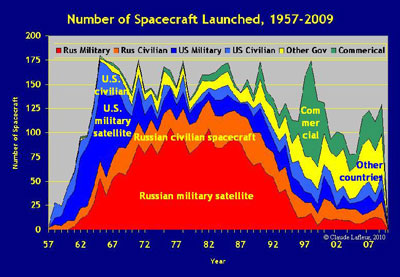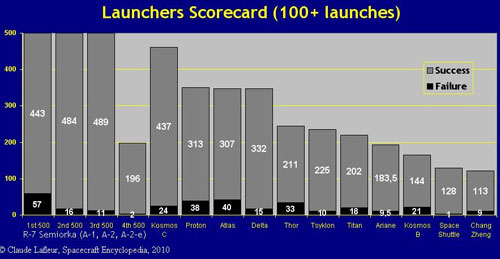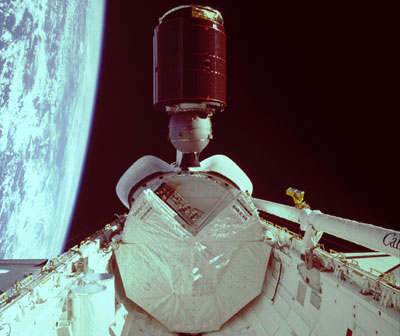Spacecraft stats and insightsby Claude Lafleur
|
| It’s worth noting that it is impossible to establish a definitive number of spacecraft launched since it depends of how you count them. |
Answering these questions tells us a lot about what’s going on in space. For example, more than a quarter of all spacecraft launched are used for communications, both civil and military. The country that launched the greatest number of spacecraft is by far Russia, with 57% of the total. And while in the first three decades of the Space Age two-thirds of all spacecraft were launched for military purposes, it’s been the opposite since 1995. Another interesting topic is rockets: what is the risk of flying anyone of them, and which country had the best ones? Such an overview also gives us a look at what the future can bring, specially for China. What the last forty years of Chinese’s space activities tell us about the future of this country?
Here is an overview of space activities from the standpoint of spacecraft launched. (All data are as of December 31, 2009 and are available on my Spacecraft Encyclopedia.)
 How many spacecraft should we count for an Apollo mission? Only one, if we consider Apollo as one-piece spacecraft (upper left), or three if we counted the Lunar Module, the rover, and the Apollo command module? (credit: Grumman) |
Who launches what?
First of all, how many spacecraft have been launched since Sputnik in 1957? It’s worth noting that it is impossible to establish a definitive number of spacecraft launched since it depends of how you count them. Take, for example, an Apollo lunar mission: do you count this as one spacecraft or should the Apollo command module and the lunar module be counted as two spacecraft? (I consider them as two.) And when Apollo astronauts used a lunar rover, does it count as a third spacecraft? (Yes.) Do the scientific instruments they placed on the Moon also count as spacecraft? (No.)
Separately, I counted as two spacecraft a Space Shuttle orbiter that delivers a payload into orbit. However, what about a orbiter carrying a Spacelab module inside its payload bay, or another one which delivers a module to be added to the International Space Station? (I considered that as long as a payload stay inside a spacecraft, it isn’t counted, but it is when a shuttle delivers a complete module to ISS.) Obviously, there are many other cases like these one.
So, I’ve developed a logic to count the number of spacecraft, but whatever logic you could design, there’ll always be some exceptions. However, I consider that whatever logic you could use, it will probably give the same number as mine, give or take 0.5%. Also, I use the word spacecraft to include piloted spaceships, Earth-orbiting satellites, and planetary probes.
Now the answer: as of December 31, 2009, there were 6,854 spacecraft launched. This is an average of 132 spacecraft a year over the last 52 years. This number varied from 180 in 1965 to only 77 in 2004 (see Table 1).
Of those spacecraft, 3,543 are Russian and 1,811 are American. All other countries (including Europe, Japan, China, and India) had sponsored only 808 spacecraft. There are also 580 commercial spacecraft and 112 built by amateurs and students.
 Some 6,854 spacecraft were launched between 1957 and 2009, 52% of them for Russia (in red), 26% for the United States (blue), 12% for other countries (yellow) and 10% for corporations and amateurs (green). |
Of all these spacecrafts, 55% were for military purposes and 45% for civilian ones. Note that the military trend is on a sharp decline since it peaked in the mid-1980s at around 66%, and fall at only 20% today. Thus, space is not a military zone as it once was. (See Table 4.)
We could classify the civilian spacecraft in three broad categories: space exploration (which include piloted spaceflight, earth/space science, planetary exploration, and astronomy), applications (communications, meteorology, and remote sensing), and research and development (technology and amateur/student-built satellite). Of the 3,099 civilian spacecraft launched, 40% were for exploration, 48% for applications, and 12% for R&D. (See Table 10.)
The military spacecraft could be classed in three broad categories: applications (earth surveillance and electronic intelligence), services (communications, navigation, and meteorology), and research and development (including “space defense”, antisatellite, and other technology developments). Of the 3,755 military spacecraft launched, 48% are for applications, 36% for services, and 16% for R&D.
| Of the commercially available launchers, the Russian Semyorka (aka Soyuz) is number one in many ways. First, it is by far the most used: 1,698 Semyorka have been launched in 52 years—one every 11 days! |
Now, we have to make a distinction between the number of spacecraft launched by a country and the number it sponsored, considering that Russia, the United States, and Europe launch commercial satellites and spacecraft for other countries. Thus, while 52% of all spacecraft are Russian, this country has launched 57% of the total. As for the United States, it owns 26% of all spacecraft but has launched 33% of the total. (See Table 12.)
Come fly with… whom?
Say you want to fly onboard a rocket, or that you have a $100-million satellite to put into orbit. Which one should you use?
Since the dawn of the Space Age, some 5,038 rockets have been launched, mainly by six countries: Russia, United States, Europe, China, Japan, and India. There are 47 families of launchers, 26 of which have flown at least ten times. (See Table 11.)
Of those 26 launchers, the most successful is the Saturn family; it recorded 28 successes in 28 launches. It is followed by the Space Shuttle, with 128 launch success in 129 flights. (The loss of Columbia is not counted since it occurred at reentry.) Even so, you couldn’t fly onboard those government rockets.
Of the commercially available launchers, the Russian Semyorka (aka Soyuz) is number one in many ways. First, it is by far the most used: 1,698 Semyorka have been launched in 52 years—one every 11 days! It is also the most successful. In the last 18 years (since the demise of the Soviet Union), 252 Semyorka were launched with only 4 failures, for a success rate of 98%. Compare this to:
- Delta: 347 launches with a 96% success rate,
- Ariane: 193 launches with a 95% success rate,
- Proton: 351 launches with a 89% success rate, and
- Atlas: 347 launches with a 88% success rate.
(See the scores for all launchers in Table 11.)
Another way to compare space launchers is to consider all the ones launched by each country. Russian launched 60.5% of the 5,038 rockets, the United States 30%, and the rest of the world less than 10%. As for the overall success rate, Russian launchers scored 93%, United States 90%, Europe 92%, China 89%, Japan 84% ,and India 71%. (See Table 12.)
Of all the 5,038 rockets launched to date, some 4,621 accomplished their mission, with a success rate of 92%. This means that if ever you have to fly anyone of them, you have 11 chances in 12 of getting into space. And your best hopes are onboard a Russian rocket: 15 chances in 16.
 Here are the twelve rockets that have been launched at least 100 times. This graph shows that the Russian Semyorka has been launched 1,698 times (with 88 failures, in black), followed by the Kosmos C launcher (with 461 launches and 24 failures), then by the Proton (351 launches, with 38 failures), and by the Atlas (347 launches and 40 failures). |
The Chinese myth
These days there is a lot of talk about China becoming the space power of this century. However, in this essay, we haven’t mentioned China a lot. Why? Because it hasn’t accomplished a lot compare to Russia and the United States.
For instance, in 40 years of space activities (1970-2009), China launched only 132 rockets and 166 spacecraft. That is far less than what the Soviet Union and the United States had done in the first decade of the Space Age. During this decade, those countries had not only launched communications, weather, spy, and navigation satellites (as China did later), but also they had explored many times the Moon, Mars, and Venus. China, in contrast, has only launched one lunar probe.
China is frequently presented as the space power that will soon rival, if not surpass, the United States. Some say it even could put a man on the Moon before the US tries again!
| Could China be on the Moon in the 2020s? At the pace they are progressing, it will take them decades to do so. |
However, what have the Chinese done since the launch of their first unmanned Shenzhou capsule in 1999? They only flew six more Shenzhou, three of them piloted by a total six taikonauts who spent nine days in space. In comparison, during the first ten years of their piloted programs (1960–1969), the Soviet Union and the United States each flew three dozen such spacecraft (manned and unmanned). Twenty-four Soviet cosmonauts spent 42 days in space, and 44 American astronauts spent 96 days. And during these years, the United States even walked on the Moon twice! Don’t forget also that many argue that the Chinese didn’t develop their own piloted capsule, but instead acquired Soyuz blueprints from Russia.
During the decade the US took to go to the Moon, it launched some 600 rockets and 800 spacecraft, in comparison to China’s 132 rockets and 166 satellites in 40 years. These numbers are not simply rhetoric: they show that, in the process, the US learns how to deal with the unexpected. As far as we know, the Chinese haven’t been confronted with any emergencies. In 40 years of space activities, they haven’t even experienced the pace of space operations needed to conquer the Moon. As the American experience shows, you don’t have to learn only how to fly in space, but also how to react in face of the unexpected and at life-threatening emergencies. You have to prove that you’ve got the “right stuff.” After 40 years of space activities, the Chinese are far from that.
Could they be on the Moon in the 2020s? At the pace they are progressing, it will take them decades to do so. The fact is: we have plenty of time before China becomes a space power able to rival Russia and the United States.
